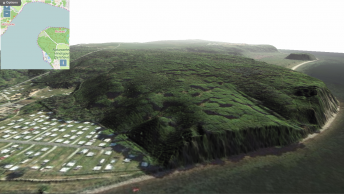We visualize Denmark’s Digital Elevation Model in real-time, directly in a browser using WebGL. A virtual texturing technique is applied which enables us to handle a virtual raster size of 1048576 x 1048576 pixels. Hence, it is possible to cover the whole country, except Bornholm, with 40 cm horizontal resolution. Online demo: http://denmark3d.alexandra.dk References: Making Digital Elevation Models Accessible, Comprehensible, and Engaging through Real-Time Visualization
In our Advanced Technology Foundation project “FutureSonic”, we recently presented two papers at the 2014 IEEE International Ultrasonics Symposium together with our research partners at the Technical University of Denmark. The first paper [1] presents how ultrasound images can be computed efficiently on GPUs and on multicore CPUs that support Single Instruction Multiple Data (SIMD) extensions. We were able to accelerate a reference implementation in C from around 700 ms/frame to 5.4 ms/frame using the same multicore CPU. The speedup…
Recently, the Danish Geodata Agency released a new high-resolution LiDAR pointcloud dataset of parts of Denmark. We have developed a real-time terrain visualization that runs entirely in a web-browser using WebGL. The terrain model was generated from the pointcloud (17.6 billion points) to a raster map with 40 cm lateral and longitudinal resolution and 1 cm height resolution. In the final visualization, we have added overlays from satellite photos and from OpenStreetMap as shown in the screenshots. A demo video…
We have successfully demonstrated the first ultrasound images in our Advanced Technology Foundation project. The demonstration was presented today at an event at the Center for Fast Ultrasound Imaging at the Technical University of Denmark. The picture shows images acquired and processed in real time using our newly developed software (left) and the corresponding raw image produced by a commercially available scanner from BK Medical (right). We will continue working on improving the image quality. Details about our software implementation…
We presented our WebGL raytracer at the Visionday 2013 event. Material presented in the talk: Slides (pdf) Demo 1: Motorcycle Demo 2: Cornell box Xmas theme Usage Use the left mouse button and the keys “wasdqe” to control the camera. Use the right mouse button to select objects in the scene. The active object can be translated with the gizmo and the material can be changed in the column on the right hand side. Requirements You should ensure that you…
We recently published a pathtracer that runs in JavaScript and WebGL (link). The WebGL pathtracer is inspired by a pathtracer that we previously implemented in C++ with OpenGL shaders written in the OpenGL Shading Language (GLSL) 3.3. However, since WebGL 1.0 uses a simpler version of GLSL, namely the OpenGL ES shading language 1.0, we encountered some language constructs that were not supported. This post describes some of the challenges we encountered in order to implement our pathtracer in WebGL…



